You Can Regrow Greens From Carrot Top Scraps And Potentially Collect The Seeds

VEGETABLES > CARROTS > TOPS

Elizabeth is a Permaculture Garden Designer, Sustainability Consultant and Professional Writer, working as an advocate for positive change. She graduated from the University of St. Andrews with an MA in English and Philosophy and obtained a Diploma in Applied Permaculture Design from the Permaculture Association.
Reviewed By PETER LICKORISH

Peter is a Horticulture Lecturer and self-employed Horticulturist, with a passion for diverse areas of the industry - from garden design to the science behind plant growth and propagation. He has completed the Royal Horticultural Society’s Master of Horticulture (MHort) Award and lectures on RHS courses at Bedford College.
IN THIS GUIDE
CARROT GUIDES
Common Problems
Container Growing
Feeding & Watering
Growing From Tops
Harvesting
Sowing
Carrot tap roots won’t regrow once chopped off, but you can regrow carrot greens and potentially collect seeds from the plants to sow next year.
Learn how to grow carrots from carrot tops and you can make the most of even the vegetable scraps from your garden.
You could, of course, simply decide to place carrot tops in your composting system to recycle their nutrients into the garden system – but before you relegate carrot tops to the compost heap or bin, you might want to consider this fun and useful project.
It is important, first of all, to understand that when we talk about growing carrots from carrot tops, we do not mean the colourful tasty tap roots.

These, unfortunately, are a ‘one-hit wonder’ and will not regrow from the carrot top no matter how long you wait.
However, when you place carrot tops in water or a suitable growing medium or soil, you can grow a supply of fresh carrot greens.
And, if you leave the plant to grow on, these biennial plants will flower and set seed, and you could potentially collect the seeds from these plants to sow in your garden to grow new carrots for their roots from scratch next year.
Why Regrow From Carrot Tops For Greens?
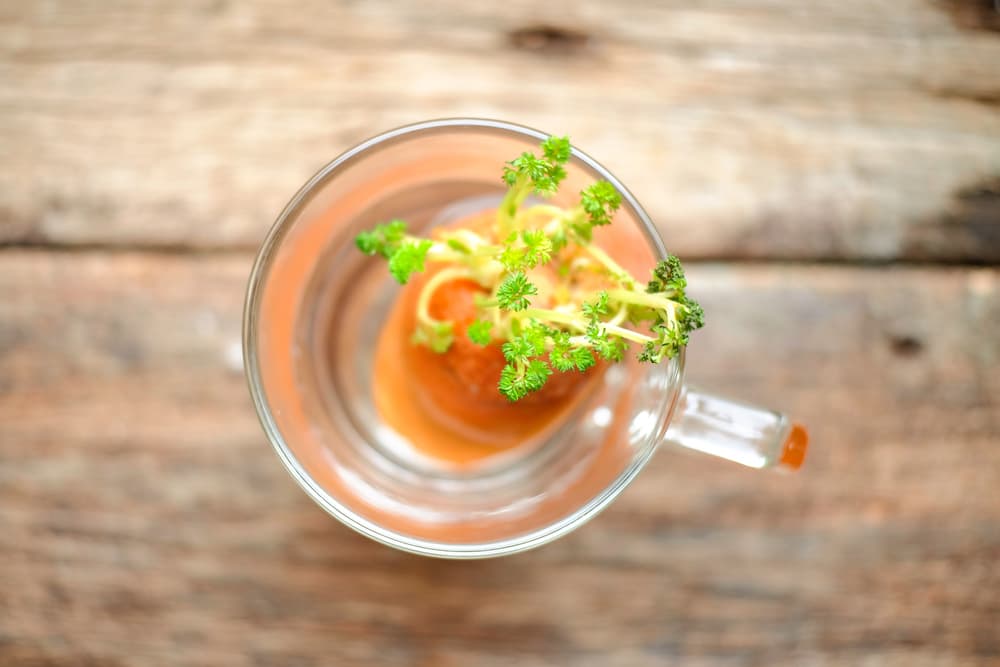
When you think about eating carrots, you are most likely to think about eating the roots.
Many people are unaware that you can also eat the green leafy foliage that grows from the top of the taproot.
This secondary yield from carrots has a rather strong carrot or parsley-like flavour.
The fronds can be added in moderation to mixed salads, or used much as you would use parsley, as a pot herb – it can add flavour to a wide range of recipes.

While the plants regrow, they can also make rather attractive houseplants for a sunny windowsill.
They have soft feathery fronds, and when grown correctly, can flower with delicate flowers and then set seed.
Regrowing carrots is a fun activity to enjoy with kids, or simply to hone your own simple growing skills.
And there is a lot of satisfaction to be had in really making the most of a homegrown carrot crop, or of parts of your purchased carrots that might otherwise have been thrown into the composting system.
1) Selecting Carrots To Regrow

The first thing to think about is the carrots that you select to regrow.
If you grow your own carrots, you should consider saving the tops of the best and healthiest specimens.
I’d recommend that you choose organic, heritage options.
If you wish to save your own seeds it is important to remember that hybrid varieties will not ‘come true’.
In other words, the plants which grow from the seeds may not be the same as the parent plant they came from.
“Heritage or heirloom varieties also may not produce ‘true’ seed if there are other varieties nearby with which they have cross-pollinated,” adds Master Horticulturist Peter Lickorish.

If you have purchased your carrots, from a supermarket, farmer’s market, farm shop or through a veg box scheme, you might not always know which type of carrot you have.
Remember, where possible, purchasing organic produce direct from the producer is the most eco-friendly and sustainable option.
While this is more expensive on the whole, learning about regrowing can help you buy less and eat better for less overall.
2) Choosing A Method

Once you have your carrots, simply cut off the ends of the roots from which the foliage grows, leaving around 2cm or so of the taproots.
Eat the rest of the carrots, or set them aside to eat later – what comes next could not be easier.
“If the carrots have foliage, cut this back to a few centimetres, because until new roots form, this growth will only wilt,” shares Peter.
You simply need to place the carrots, cut side down, in a position where new shoots will emerge from the top, and small hair-like roots will emerge around the edges of the former tap root.
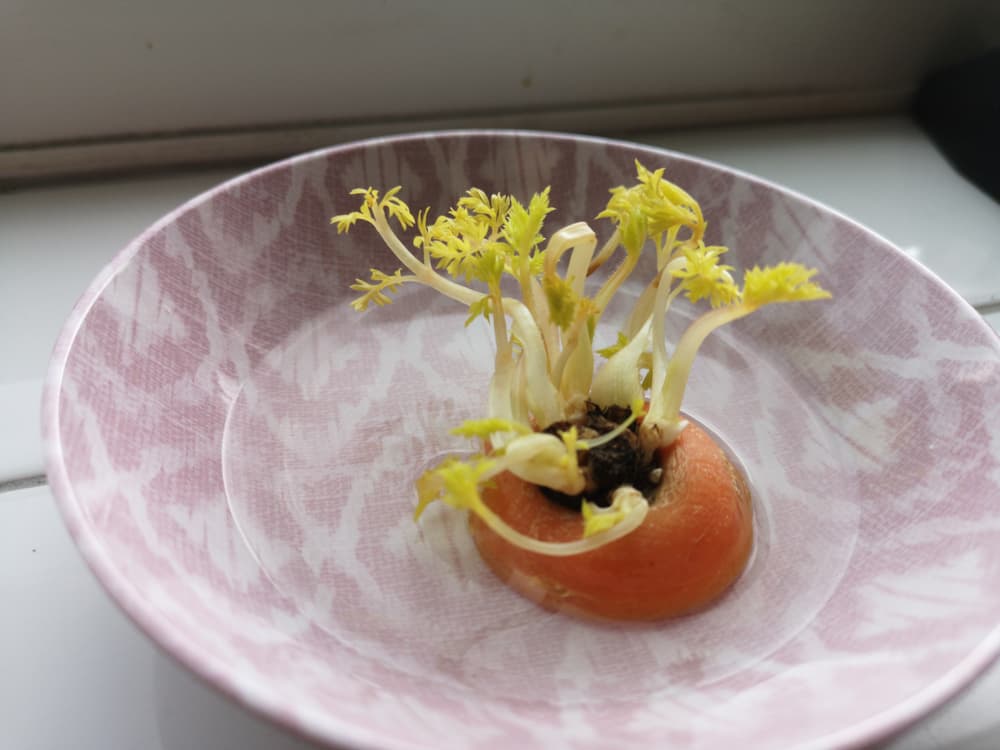
For this, sunlight and water are required.
There are a few different methods you could use in terms of where exactly you position your carrot tops. You can:
- Place the carrots into a shallow tray or saucer of water.
- Arrange the carrots on top of damp pebbles surrounded by water in a tray or on a plate.
- Layer damp newspaper or scrap untreated paper/card in a shallow container and place the carrot tops on top of that.
Whichever option you choose, you should place your carrots on a sunny windowsill.
3) Waiting For Shoots & Hair Roots

Once you have placed your carrot tops in a suitable location, the next job is simply to wait for new shoots to emerge from the top of each one.
This should not take very long at all and usually, you should see new growth within around a week or so, perhaps even sooner.
As well as seeing fresh green growth at the top of the new plants, you should also see, before too long, small new roots like little hairs coming out around the edges of the former tap root.
Once you see some of these new roots, you can think about planting up your new carrot plants into their own pots, within the next couple of weeks, so you can continue to enjoy them as houseplants within your home or plan them out into the soil in your garden if it is between late spring and late summer.
4) Planting Sprouted Carrot Tops

Carrots need a moist yet free-draining medium, such as peat-free compost, and the right conditions are easy to achieve when growing them in pots for this secondary yield of leaves, or letting them grow on to produce seeds.
Simply place your carrots in small pots filled with a suitable growing medium, so that the top crown of the carrot is just sticking above the surface of the potting mix.
Then watch your carrots grow and harvest the foliage as and when required or desired.
“If you have got the bug for propagating your own veg plants from their tops, why not try the same thing with pineapples?” asks Peter.
“Their tops can be used to grow another fruit, but you’ll need patience as this can take a couple of years.”
5) Saving Carrot Seeds
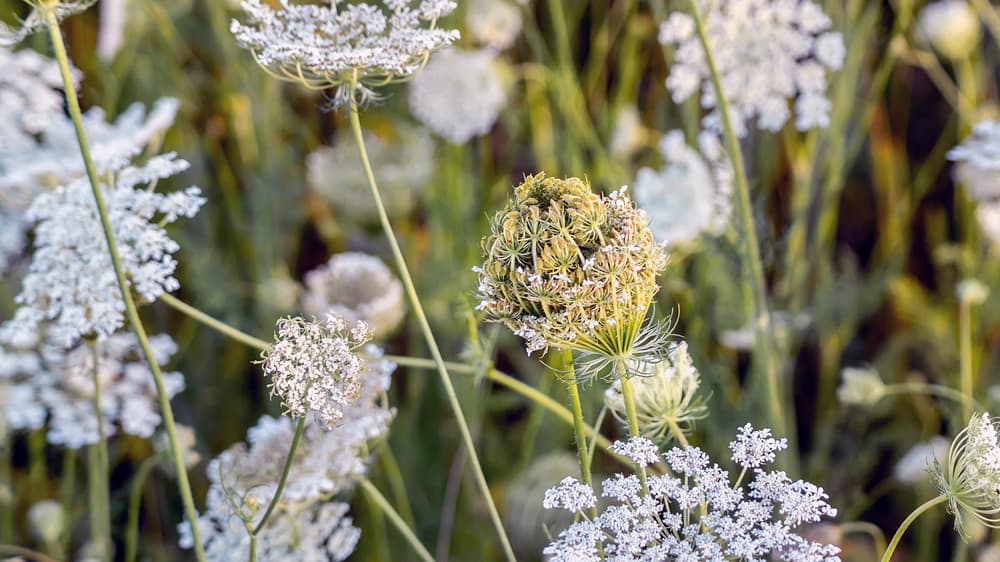
If you leave your carrots to mature, they will grow larger, flower, and form seeds.
Carrots are biennial, which means that they go to seed in their second year.
When you grow carrots from carrot tops, you are allowing carrots to enter this second phase of their life cycles.
Just remember that if you want to save seeds from your carrots, these will not necessarily have the same, tasty tap roots as the original unless you have a heritage or heirloom variety.
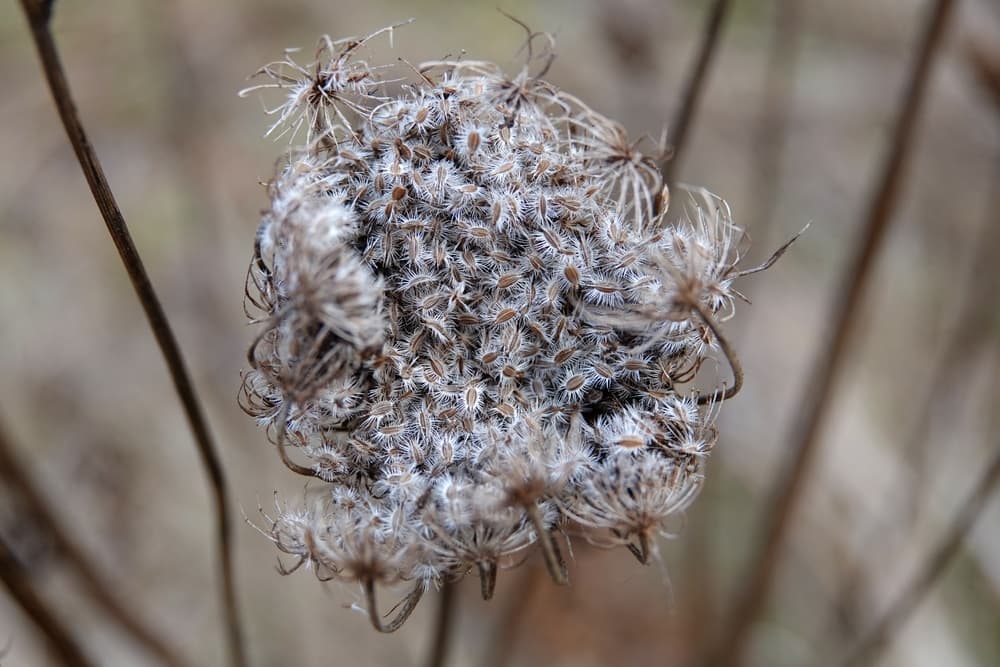
Carrots grown from tops may not always develop full flowering heads.
If you want a more reliable way to save seeds then leave a few carrot plants unharvested to flower the following summer.
However, if your carrot regrowth does flower, you can leave the head to fully mature.
Wait until the flowering head begins to turn brown and dry out, then carefully cut it off.
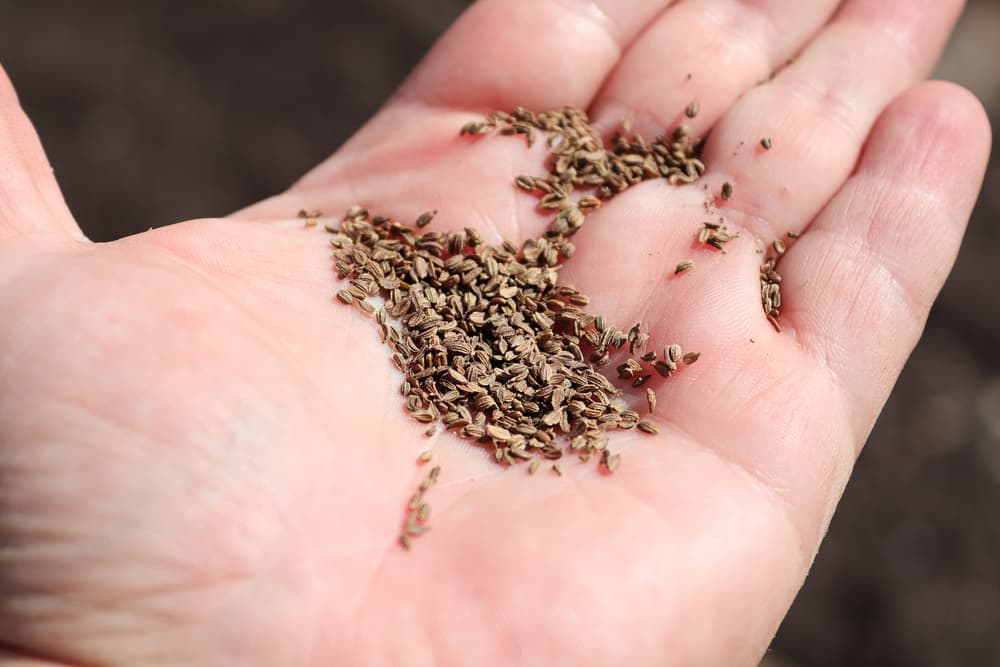
Place it in a small paper bag where drying can continue, and the tiny seeds will fall from the heads into the bag with a gentle shake.
You can now retrieve and store the darkened little seeds in a cool, dry location in an airtight container and sow them the following year, either in containers, or outdoors in your garden.
By selecting and saving seeds from heritage carrot varieties, you can selectively breed carrots ideally suited to the conditions where you live and create closed-loop, sustainable growing systems in your garden.
